Child scavengers — casualties of the Philippines' war against waste
By Hannah Alcoseba Fernandez
Photos by George Buid
4 August 2022

Advocates for landfills believe that they are a convenient solution to the country's chronic garbage crisis, but over-dependence can create negative impact for communities living in the vicinity, including for children who sift through waste heaps just for something salvageable to sell.
With the Philippine government eyeing to build 300 of such new 'sanitary landfills' by the year's end, it could mean bad news for those looking to improve the welfare of the young waste-pickers.

Rachelle Anne, a child waste-picker, and her grandmother in front of their makeshift house in Barangay Aroma in Tondo, Manila.
Rachelle Anne, a child waste-picker, and her grandmother in front of their makeshift house in Barangay Aroma in Tondo, Manila.
Eight-year-old Rachelle Anne is doing her homework on an electronic tablet along a walkway littered with trash in an impoverished district of Tondo in the Philippine capital of Metro Manila.
Ironically called Aroma, the barangay or village is home to 2,000 families like Rachelle Anne’s who are now oblivious to the stench of garbage wafting in the air, and the piles of throwaway plastic in their surroundings.
For Rachelle Anne and many other children, schoolwork is not their only preoccupation. Before attending online classes, Rachelle Anne wanders the streets of the neighbourhood, spending all morning scavenging for something from the piles of waste scattered everywhere. Today, she is paid for a sack of mineral water bottles that she has found, after cashing it at a junk shop.
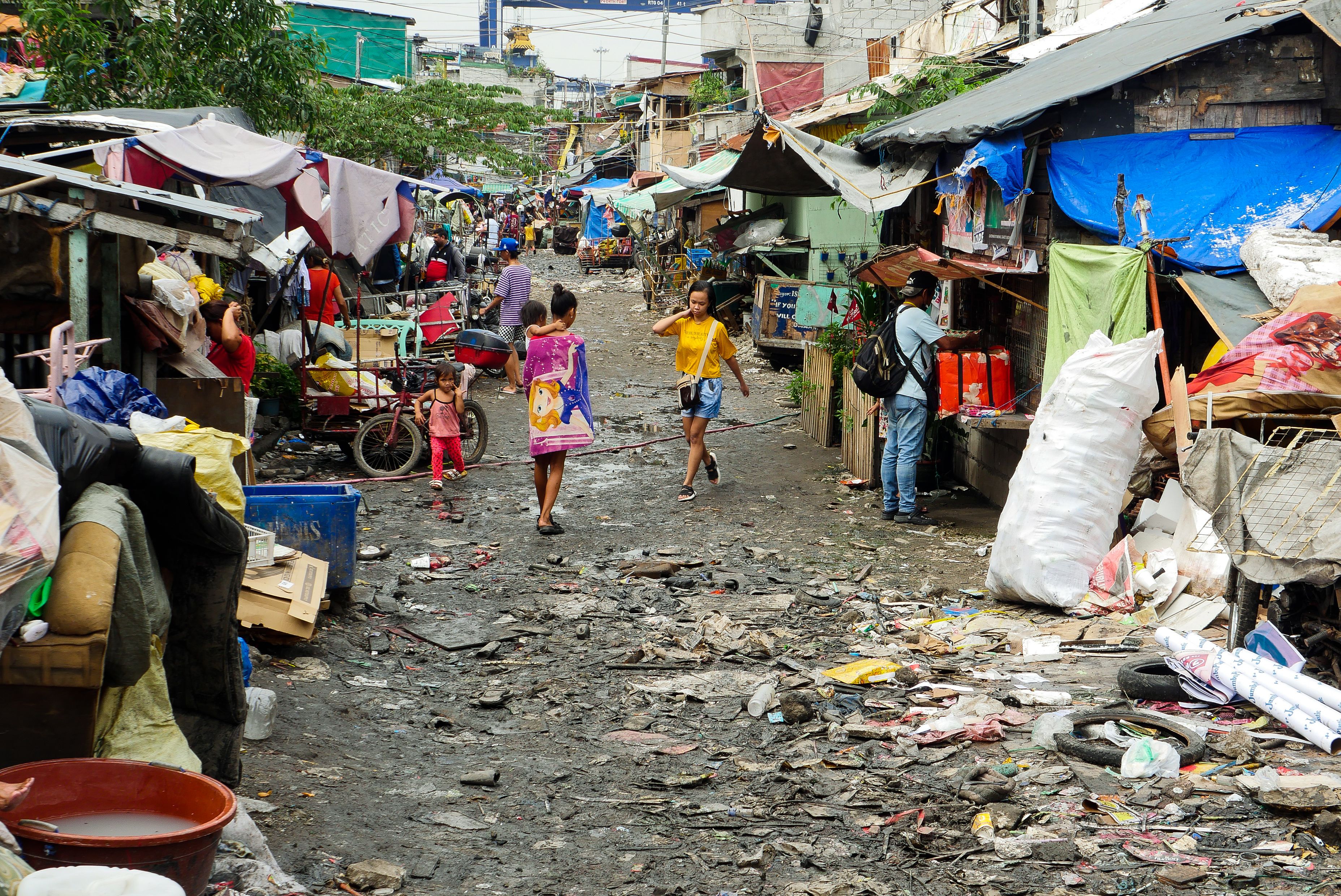
A typical scene in the shanty town of Barangay Aroma. The government shut down Smokey Mountain in 1995 and attempted to relocate its residents. Aroma was one of those temporary sites, but decades later, people still live there.
A typical scene in the shanty town of Barangay Aroma. The government shut down Smokey Mountain in 1995 and attempted to relocate its residents. Aroma was one of those temporary sites, but decades later, people still live there.
Barangay Aroma used to be just three kilometres away from Smokey Mountain — an infamous large open dumpsite where over 98,000 trucks full of waste collected from all over the city capital were deposited. Then, about 30,000 people had made their living from picking through the landfill's rubbish, but after the smouldering mass of garbage became too much of a dark symbol of poverty in the Philippines, it was shuttered in 1995. The land was turned into tenement housing for its former dwellers.
In 2000, the government started prohibiting the establishment and operation of open dumps, after a catastrophic waste avalanche in the Payatas dumpsite in Quezon City the same year took about 300 lives, child scavengers included. However, despite the ban, living among garbage or near such open dumps has been a regular way of life for many locals.
Two decades later, in a bid to improve the country's solid waste management, the government laid bare an ambitious plan to build 300 new landfills by this year. The sanitary landfills are to replace current open dumpsites.
According to Barangay Aroma officials, once waste pickers salvage what they can from garbage piles, collectors will retrieve the leftover rubbish and bring them to a nearby pier where a barge brings the accumulated refuse to a closed sanitary landfill in the province of Bataan, about three hours away.
The pay one gets for the hard work in scavenging is, however, meagre, although it is enough to buy a meal, and the children take pride in being able to get their family through another day.
“I made P50 (US$.80) today. I gave the money to my grandmother so she can buy food for us to eat,” said Rachelle Anne.
Abandoned by her parents, Rachelle Anne lives with her younger sister and grandmother in a house made of plywood and cardboard sitting precariously on top of one another, held together by wire. Her elderly guardian, incapacitated after a stroke, has no choice but to let her grandchildren fend for themselves.

Children in Barangay Aroma sorting through trash for mineral water bottles, which fetch the highest price among plastic waste, at US$0.27 per kilogram.
Children in Barangay Aroma sorting through trash for mineral water bottles, which fetch the highest price among plastic waste, at US$0.27 per kilogram.
The situation is despite the country's labour law, which mandates that children are not allowed to work in hazardous trades such as waste picking. It states that children under 15 years old cannot be employed, unless the legal guardian engages the services of the child, and the job does not endanger the child’s life, safety, health, morals and does not impair the child’s normal development.
According to the Philippine Statistics Authority, as of December 2021, there are about 597,000 child labourers aged 5 to 17 years old, a decline from two years ago. Although there are less child labourers today, a bigger proportion of them are doing hazardous work at 68 per cent — a seven per cent jump from 2019.
Hazardous work includes employment in farms and plantations, dangerous mines, factories, private homes as child domestic workers. It also includes begging or scavenging on the streets.
Waste picking can never be completely abolished if the barangay tanod — a local law enforcer who resolves petty crime in the community — turns a blind eye to the phenomenon and does not escalate the situation to the police, said Lynn Rivera, programme manager of Erda Foundation, a non-government organisation providing financial support for education of children in the slums of Tondo for the past 30 years.
“If no one is watching the children, then they will scavenge. This is the reality in the community,” Rivera told Eco-Business. “Scavenging is already in their attitude, their orientation, and how they see life. It is the come-on of money because with what they earn from waste-picking, they can buy what they want without depending on their parents.”
Lynn Rivera, programme manager of Erda Foundation, talking about why children still scavenge despite hazards and financial aid from government.
Lynn Rivera, programme manager of Erda Foundation, talking about why children still scavenge despite hazards and financial aid from government.
Scavenging is already in the children's attitude, their orientation, and how they see life.
Open dumpsites: illegal but thriving
Since the Philippines' landmark solid waste management measure in 2000 outlawed open dumps in the country, they no longer exist, according to government data.
But a trip to Angono, Rizal, about 30 kilometres east of Manila, will counter this. A dumpsite, with garbage piled to about three metres high, may be found deep within the municipality, but is only accessible to nearby barangays through an unpaved road. Garbage trucks collect trash from different parts of Angono and dump it for waiting scavengers, mostly adults. Children are not allowed to loiter or to scavenge, but there are a few who get through.
Alan Maniaol, who heads the environmental and natural resources office in the municipality, however, denies that the site is an open dump when questioned during an investigative check by Eco-Business, claiming that it is just a "temporary place" for trash before it is brought to a private sanitary landfill in the nearby town of Morong.
The area is not a dumpsite since it is prohibited under the law. It is actually a residual containment area, a place where we temporarily store residual garbage before transporting to the sanitary landfill within 24 hours.
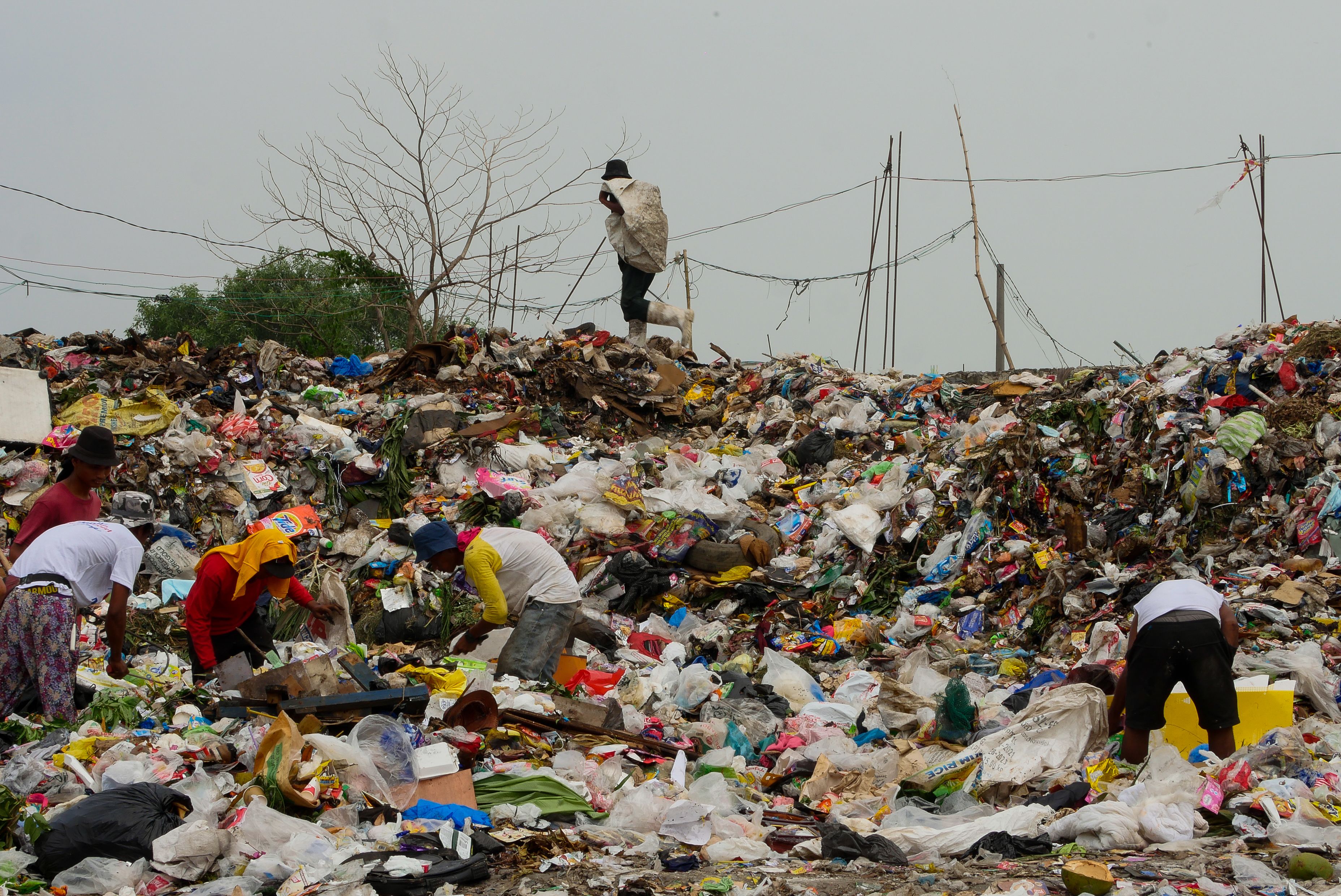
The "temporary facility" for garbage at Angono, Rizal.
The "temporary facility" for garbage at Angono, Rizal.
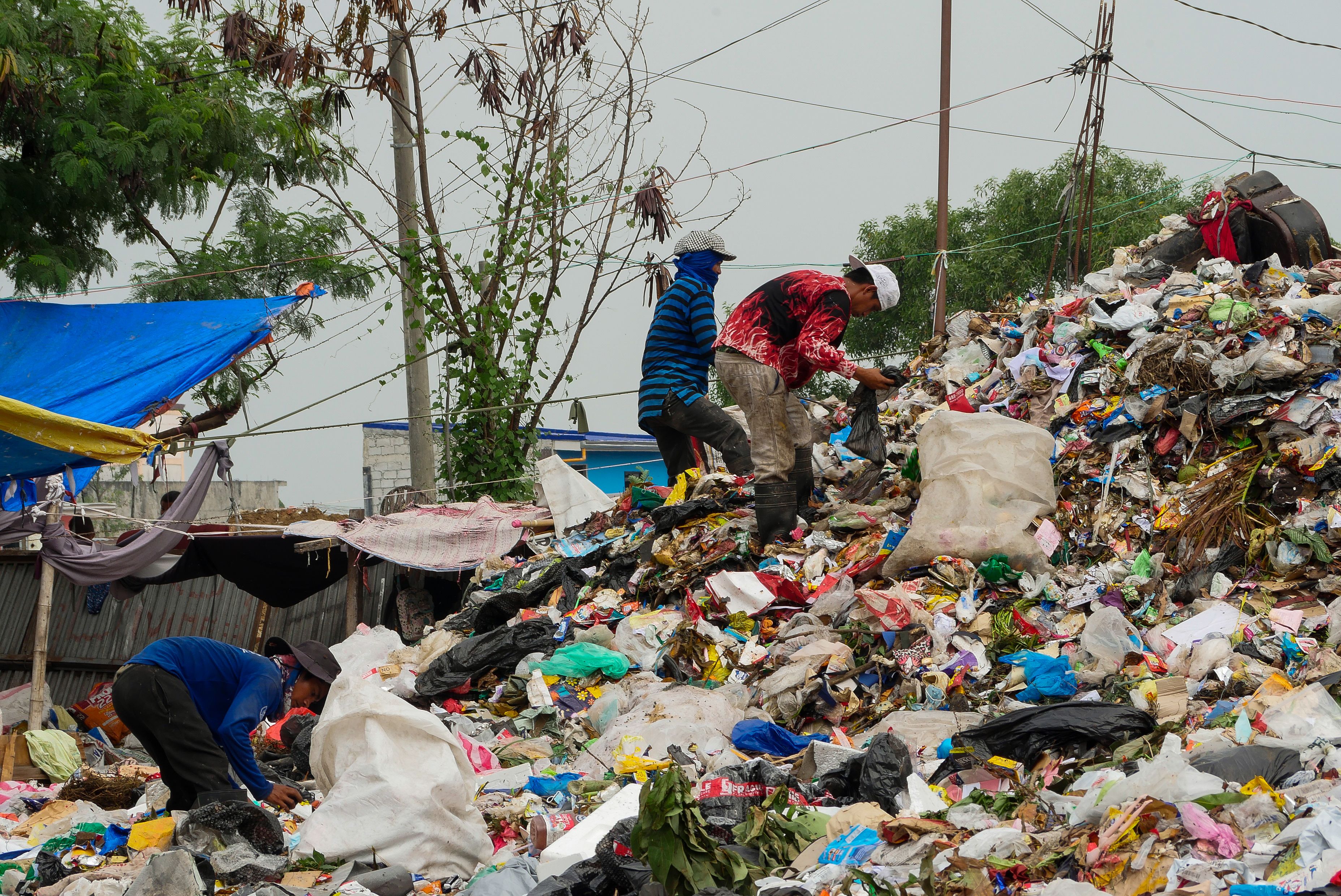
Scavengers climb up mountains of garbage to see if they can salvage anything they can sell in junk shops.
Scavengers climb up mountains of garbage to see if they can salvage anything they can sell in junk shops.
"The area is not a dumpsite since it is prohibited under the law. It is actually a residual containment area, a place where we temporarily store residual garbage before transporting to the sanitary landfill within 24 hours," Maniaol told Eco-Business. "The appearance of the facility seems like a dumpsite because it is deteriorated but we are now constructing a new facility nearby."
Maniaol said garbage trucks first bring the trash to the temporary containment area so as to "reduce the volume of residual waste".
Juvinia Serafin, chief of the solid waste management division of the Philippines' Department of Environment and Natural Resources (DENR), believes that sanitary landfills are necessary in municipalities to strengthen the capability of local government units in the disposal of recyclable and biodegradable waste.
Waste picking is prohibited on landfills, but it may not be avoided that there will be scavengers in surrounding areas.
Sanitary landfills are safer for the community because they include a proper liner system that prevents groundwater contamination and environmental impacts are properly mitigated, she said.
Even so, she admits that it is possible for waste pickers to thrive, even in controlled facilities which have stricter regulations.
"Waste picking is prohibited on landfills, but it may not be avoided that there will be scavengers in surrounding areas. What can be done is to organise and mobilise them to concentrate them at the material recovery facilities, rather than in the landfills because it is dangerous for them," she said.
Material recovery facilities (MRFs), or specialised plants that segregate materials for recycling and prepare them for marketing to end-user manufacturers, are required in every community. Waste pickers can also earn a living from separating residual waste from recyclable waste in MRFs.
But independent environmental watchdog Greenpeace Southeast Asia's zero waste campaigner Marian Frances Ledesma says that whether waste pickers are moved towards MRFs, open dumpsites or sanitary landfills or not, the fact that they exist indicates that the plastic waste crisis is one that requires urgent solving.
“The sustainable solution is to tackle plastic pollution at source through reduction, reuse and redesign. We need to drastically decrease plastic production as quickly as possible, and transition to reuse and refill models,” said Ledesma.
Building 300 landfills, but at what cost?
Two years after the DENR declared its goal of building 300 new sanitary landfills, only a handful have begun construction, due to limited resources of the cities and local government units (LGUs).
The department clarified that it only provides technical assistance to LGUs, such as in the hiring of civil engineers and geologists, in finding suitable sites for the construction of landfills, and in their design.
“The law says that the LGU is responsible for paying for the construction of their own disposal sites,” DENR's Serafin told Eco-Business.
The Ecological Solid Waste Management Act of 2000 made local councils in charge of preparing their respective 10-year solid waste management plans, which includes building a controlled landfill facility. Local government officials face administrative charges if they are unable to fulfill this commitment.
However, it is not mandatory to have a sanitary landfill for every LGU. They can cluster or share an existing landfill with a bigger municipality.
Twenty years after the legislation was passed, 246 sanitary landfills across the country have been built — a small number that is barely enough to receive the 12,091 tonnes of waste produced per day nationwide, equivalent to almost 600 garbage trucks.
According to documents shared by the environmental management bureau of the DENR, 95 barangays across the country are deemed to have feasible sites for the construction of new landfills out of 126 districts assessed.
"Properly managed landfills that comply with regulations and operational standards should not smell and should not allow for any form of scavenging," said Crispian Lao, vice chairman of the National Solid Waste Management Commission.
Lao cited how the Metro Clark Waste Management Corporation in the province of Pampanga, about half an hour away from the capital, is a private modern sanitary landfill which has strict on-site protocols to ensure the safety of its workers.
Towns in mountainous areas in northern Luzon like those in Benguet, Ifugao and Mountain Province are also starting to put up their own sanitary landfills.
If LGUs are unable to afford constructing their own landfills, they resort to waste-to-energy and co-processing projects for garbage treatment, said Greenpeace's Ledesma.
A waste-to-energy facility can already be found in Los Baños, Laguna inside the campus of the University of the Philippines, despite waste burning being prohibited under the country’s Clean Air Act.
“These alternatives are no better than landfills in that they have negative effects for our health, climate and environment,” said Ledesma.
“The national government must prioritise waste prevention to support LGUs' waste diversion targets by enacting the right policies like prohibiting single-use plastics, mandating reduction of plastic production and incentivising shifts to reusable alternatives and refill systems."
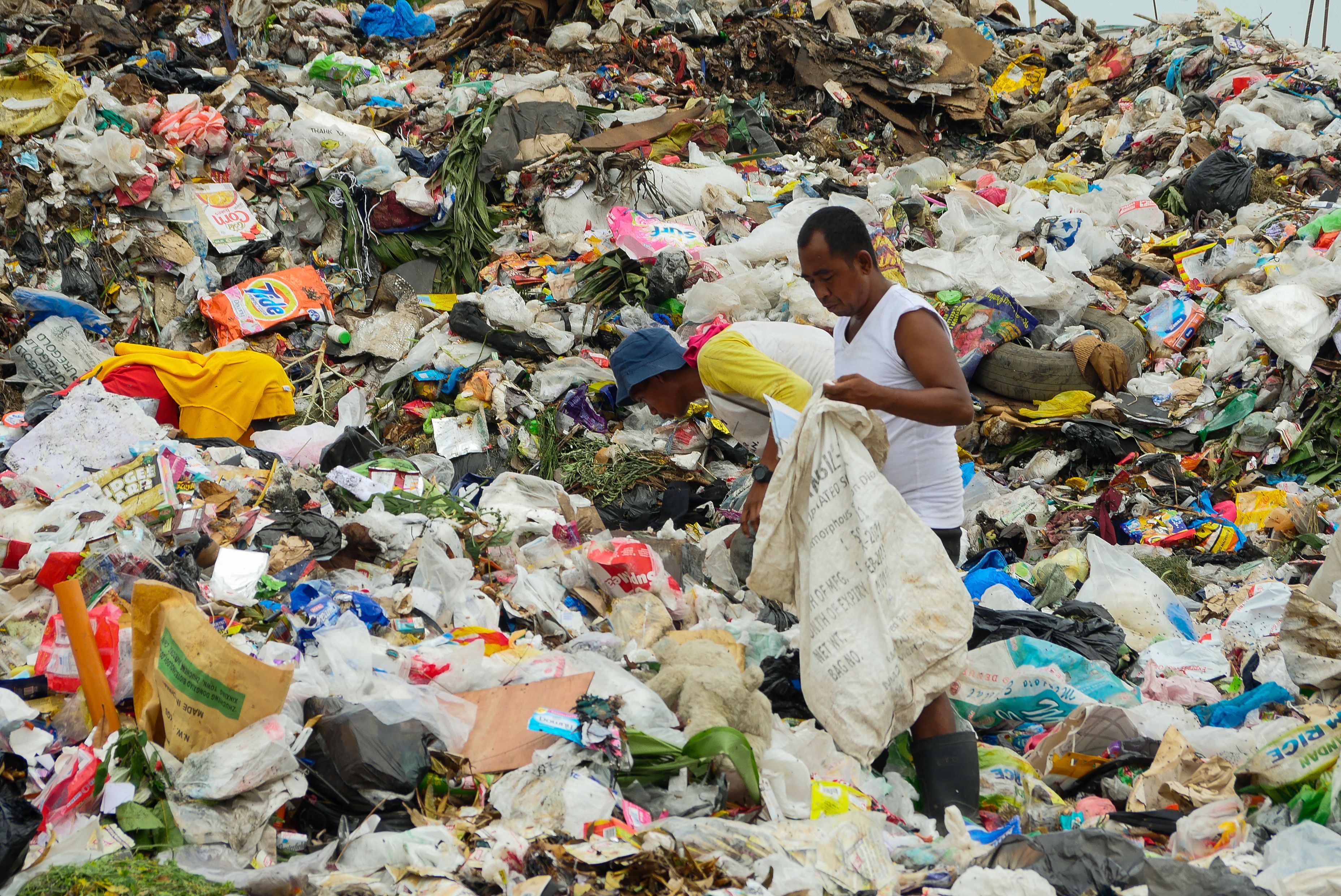
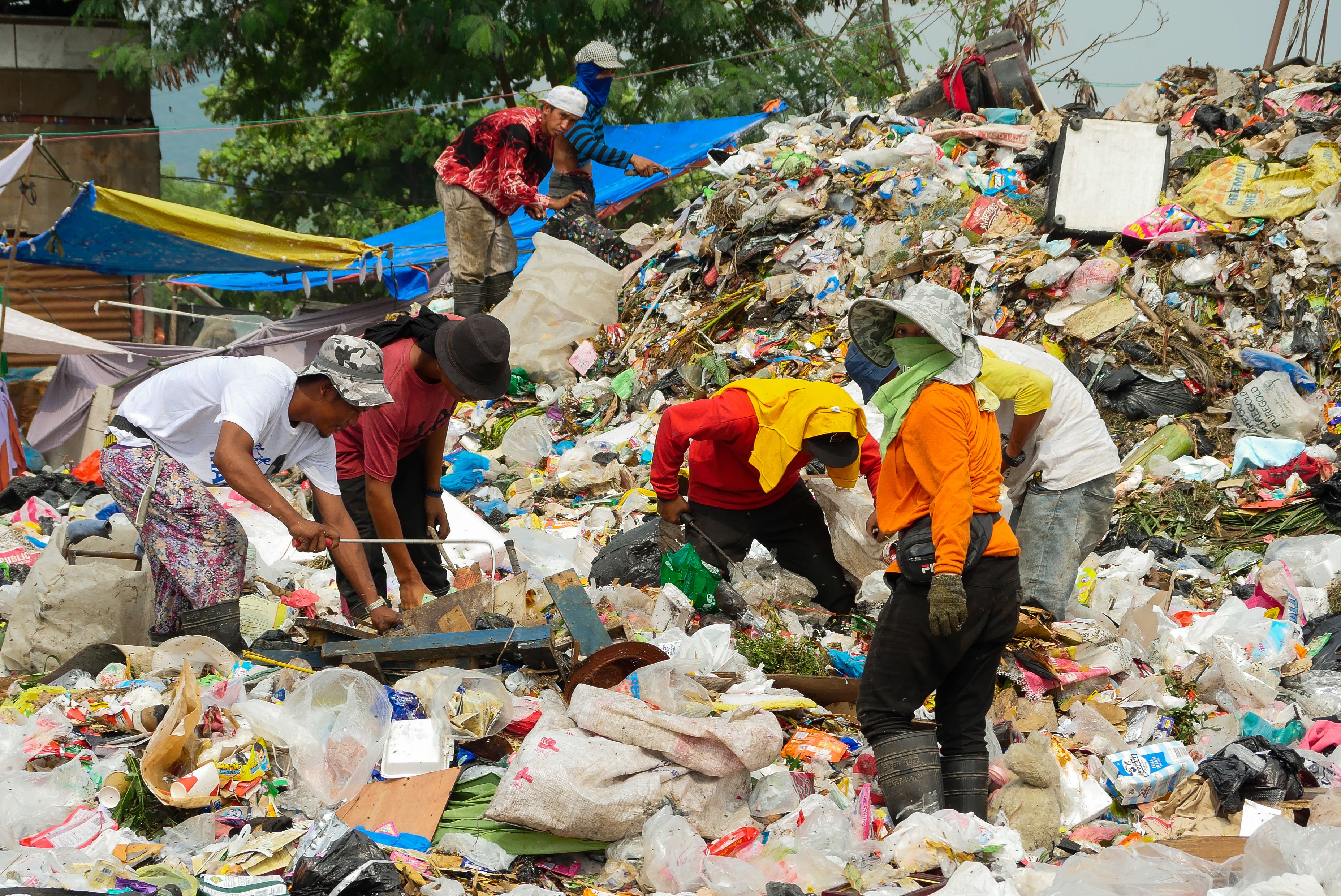
Hazardous landfills as 'last resort'
Experts say that the mere presence of landfills in a community can have environmental, health and social impacts on the lives of communities living near it, especially children who are lured by the money earned from waste picking. This is so even if the landfills are regulated.
“Landfills are a convenient solution to the plastic waste issue,” Miko Aliño, project coordinator for corporate accountability of non-profit Break Free From Plastic, told Eco-Business.
“Most cities and municipalities in the Philippines do not have proper waste segregation schemes and they are likely sending contaminated residual waste to landfills. [This is why] landfills should be a last-resort for waste handling.”
Residual waste, which refers to discarded materials that cannot be reused, safely recycled, or composted, as well as mixed waste, which contains radioactive and hazardous material, are usually sent to landfills. Releases from the waste sector are responsible for about 20 per cent of all methane generated from human activity.
Methane is a greenhouse gas that has more warming potential compared to carbon dioxide. When they are combined with the highly-combustible plastic waste, it can trigger dangerous explosions in dump sites seriously harming waste pickers, both adults and children, said Aliño.
Such an explosion happened in Delhi, India in April this year, where methane gas was blamed for a massive landfill catching fire, forcing informal waste workers to endure hazardous conditions.
“If cities and municipalities were properly implementing waste segregation, then waste pickers will not be going to disposal sites because recyclable materials have already been recovered closer to the source of waste generation like households or community materials recovery facilities,” Aliño said.
Most cities and municipalities in the Philippines do not have proper waste segregation schemes and they are likely sending contaminated residual waste to landfills. [This is why] landfills should be a last-resort for waste handling.
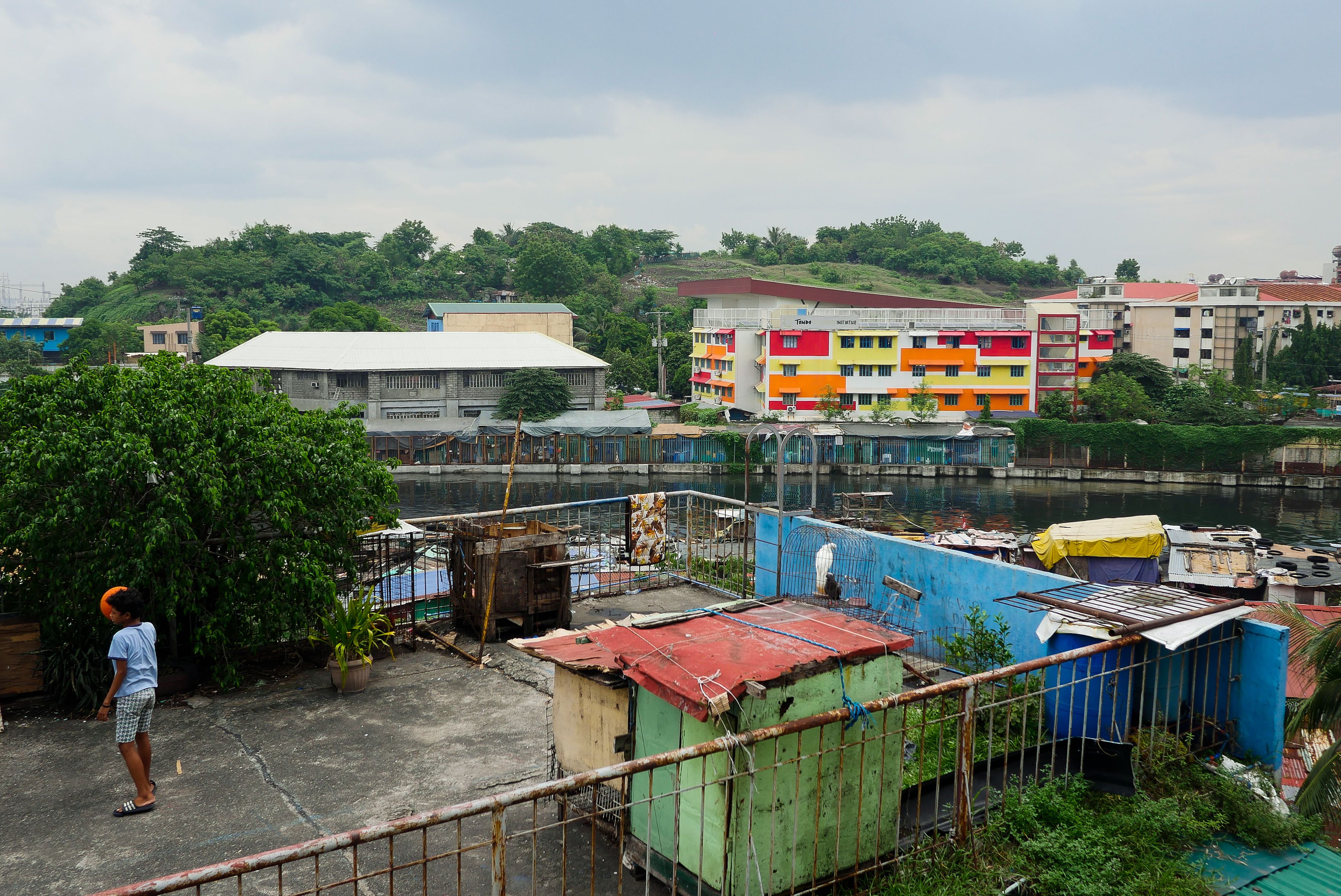
Now called "Happyland", the former Smokey Mountain open dumpsite is tenement housing for its former inhabitants.
Now called "Happyland", the former Smokey Mountain open dumpsite is tenement housing for its former inhabitants.
Waste pickers, especially children, are also exposed to serious health risks when scavenging in landfills, wrote Caroline Hunt in her study of child waste pickers in the Philippines in the early 2000s, when she was a research fellow at the London School of Hygiene and Tropical Medicine.
When Smokey Mountain was operational, child scavengers were documented to have suffered congenital deformities, respiratory diseases, very high blood lead levels, and skeletal deformities due to carrying heavy loads.
The study written five years after the landfill’s closure showed that the intelligence levels of the children waste pickers who worked there declined against the Filipino norm. Children performed worst in the areas of verbal ability, problem solving, ability to absorb new information and ability to plan ahead.
“It appears that the dull nature of the work itself and the lack of intellectual stimulation coupled with physical factors such as malnutrition and lead poisoning might play a role in low IQ levels,” read the report titled "A review of the health hazards associated with the occupation of waste picking for children".
While some child waste pickers have dropped out or have never gone to school in order to become scavengers to support their families, it is the ones who are in school that get bullied since they are in close touch with their non-squatter peers.
Mary Racelis, a veteran social anthropology professor at the Ateneo de Manila University, also noted that child waste pickers tend to drop out of school and are bullied because they are “squatters”, a derogatory term used to call people who illegally occupy an uninhabited building or unused land.
"While some child waste pickers have dropped out or have never gone to school in order to become scavengers to support their families, it is the ones who are in school that get bullied since they are in close touch with their non-squatter peers," said Racelis, whose research includes issues about poverty, urbanisation, civil society, and community development in the Philippines.
In her observation, Racelis said child waste pickers have limited access to water, so they generally do not have a chance to wash before going to school.
"Their classmates would shun them and implicitly criticise or bully them. The teachers were sometimes complicit in that when these vulnerable children would fall asleep in class, having gotten up at the crack of dawn, the teacher would scold the child, leading them to eventually drop out," said Racelis, also the former senior policy specialist, family and child Welfare and women’s development of the United Nations Children's Fund (UNICEF).
Rachelle Anne, scavenges everyday from 8 to 10am. She earns an average of US$0.90 which helps to pay for rice and food for the family.
She and her younger sister have been abandoned by their parents, who already have their own respective families. They live with their grandmother who just had a stroke. In the afternoon, she attends two hours of online classes using her tablet.
Twelve-year-old Raven helps his mother with waste scavenging because she is not strong enough to push the sidecar, which is used to carry the garbage they collect. Every night, he accompanies her as she scours through trash piles in the neighbourhood they live in.
Raven's mother says she feels bad asking her son to scavenge but since her husband died, she has been the sole breadwinner of the family. Raven says he does not mind the work. He uses the extra money for his video games.
Seventeen-year-old Jeffrey has been scavenging for waste for the past five years. It is a trade passed on from his parents. He gets sick from respiratory problems due to scavenging, but continues the work. Due to the Covid-19 pandemic, he stopped schooling altogether, skipping the virtual classes as did not like them, deciding that he will just help his parents with waste scavenging. Sometimes, he gets into scuffles with other kids when they vie for plastic waste that can fetch a higher price.
Eight-year-old June Andrei does not like scavenging through trash. He only scours through debris from fires, which happens often in Tondo because buildings and houses are built close to each other in the shanty town. He earns about US$0.16 per kilo from the steel and iron alloys he recovers out of burned buildings.
The child wastepicker's plight
Professor Racelis said sanitary landfills may be beneficial as long as the government creates pro-poor programmes to support the waste pickers.
"Unsanitary landfills are far from ok, but if they exist, governments need to turn them into sanitary landfills that are less threatening to the surrounding population's health while still allowing people to sort through the refuse and take items they can sell," she said.
She cited the government's Pantawid Pamilyang Pilipino Programme, known as 4Ps as a successful government scheme which provides mothers about US$5 per month for each child under 14 years old attending school from extremely poor households to improve their health, nutrition and education.
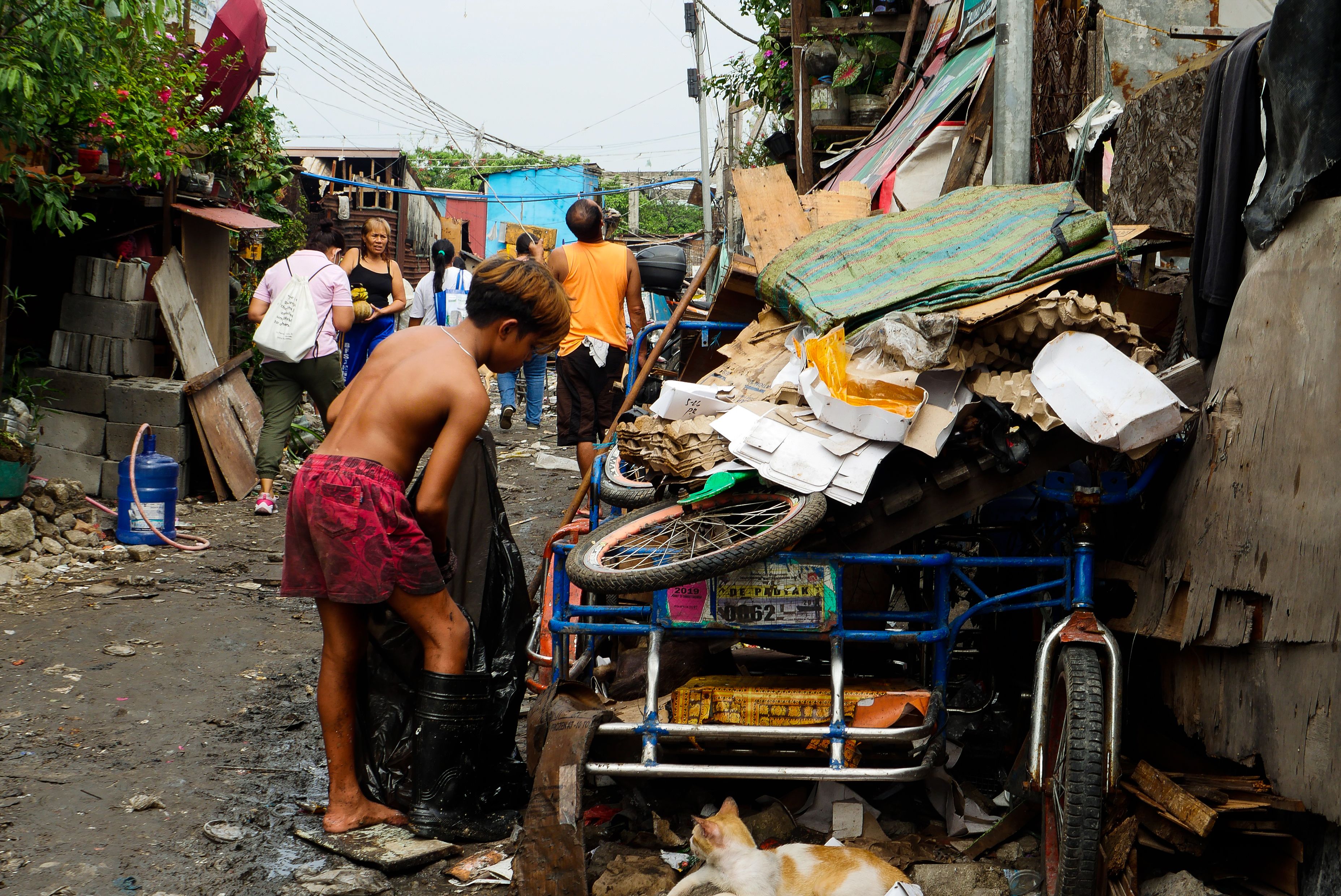
A young boy salvages some recyclables from a trash heap in Barangay Aroma.
A young boy salvages some recyclables from a trash heap in Barangay Aroma.
"It is the responsibility of the government to look for alternative means of income for those scavenging in the open dump sites because their earnings are taken away by the sanitary landfills," Racelis said.
This is especially since the local governments will be getting 25 per cent more funding from the national government’s tax collections starting this year through the Mandanas ruling, she said.
The Mandanas ruling is named after Philippine governor Hermilando Mandanas who successfully challenged the government’s previous position that LGUs were entitled to a smaller share of national government funds.
"That money should be oriented towards the employment side so parents will have income and no longer have to send their children to scavenge," she said.
For children like Rachelle Anne, whose elderly guardians cannot work, options are limited. But Erda Foundation's Rivera said that as long as children continue to seek help, especially for schooling, whether it may be from the government, non-profits, private individuals or groups, there is still hope for them.
Rivera said: "Sometimes there are relatives who can help, but when do they stop assisting then? We try to make these children realise that they cannot do it on their own and they need outside help to survive."
With additional reporting from George Buid. This story was produced with the support of Internews’ Earth Journalism Network.
Eco-Business reported on the lives of waste pickers in Indonesia in 2023.
